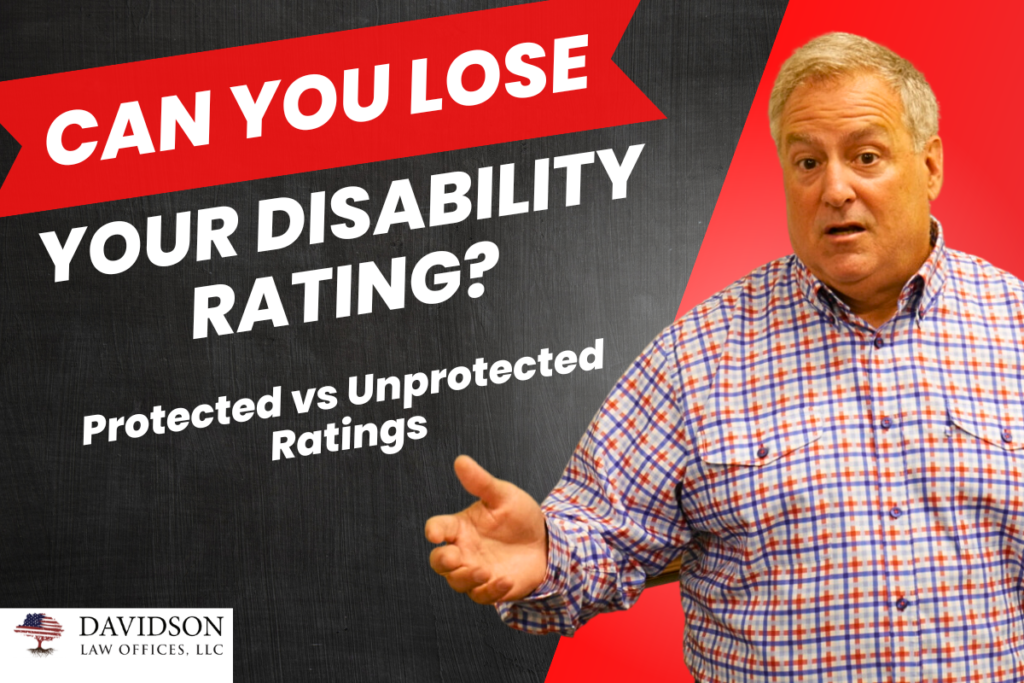We’ve gotten a lot of questions lately about protected vs unprotected VA disability ratings. Many people are worried that they’re going to be subject to a new C&P exam and that their rating is going to be reduced. Here we’ll explain how your VA disability rating can be protected and what to do if it’s not protected.
Re-Examination by the VA
Sometimes the VA will re-examine you and determine that your disability has improved to a certain degree. We hope and pray that your disability does improve, because your quality of life will likely improve as well. In cases where the VA deems that your disability has improved, they make seek to reduce your disability rating or terminate your service-connected disability entirely.
This happened to a former client of mine in southwest Georgia. He was a tunnel rat in Vietnam and later got prostate cancer that was connected to his time in Vietnam. He was successfully treated for prostate cancer, and his doctor reported that he was in remission. The VA took this to mean that he was cured, although you’re never technically cured from cancer. They reduced his VA disability rating from 100% to 40%. This was a big tragedy, but thankfully there are rules against this.
A reduction in your VA disability rating is only permitted where certain circumstances exist and where particular legal guidelines have been satisfied. The VA has the burden of establishing a preponderance of evidence that a reduction in your VA disability rating is warranted under the regulations. However, these “regulations” are basically just the VA’s interpretation of the laws that govern them. To me, that seems like putting the fox in charge of the hen house. But if your VA disability rating is protected, the VA cannot reduce your rating unless you’ve committed some type of fraud while obtaining that rating.
If you have a protected VA disability rating and didn’t commit fraud, your benefits are guaranteed for the rest of your life. If your rating is not protected, the VA must ensure their requirements are met before they can reduce your VA disability rating. If they don’t follow their rules, you get to keep your current disability rating. Unfortunately for my client listed above, he passed before he was able to get his rating reinstated.
Protected VA Disability Rating
Let’s start by taking about the requirement of sustained improvement to reduce a VA disability rating. If your VA disability rating has stabilized or continued for a period of five years or more, you’re protected. Your VA disability rating can’t be reduced unless all the evidence in the VA record shows a sustained improvement in the disability. The VA cannot use a single examination to reduce your rating. They have to look at your entire medical record to make this decision of sustained improvement.
Your medical history will help protect your rating from an inaccurate report by a single examiner. If you do get an unfavorable exam that says you’re totally healed, you are entitled to get a second opinion from your medical providers.Your disability may be subject to temporary or occasional improvement, but again is not going to be reduced based on the findings of a single examination. The VA will consider whether all the evidence makes it reasonably certain that an improvement will be maintained under the ordinary conditions of life.
If your VA disability rating has been continuously at a particular level for 20 years or more, the VA cannot reduce your rating unless you’ve committed some type of fraud obtaining that rating. Let’s say you were a Veteran granted an original VA disability rating of 30% and your rating varied between 30% and 100% over the past 20 years. Under this 20 year rule, the VA cannot reduce your rating below 30%.
How Does Rating Reduction Occur?
If the VA is considering reducing a disability rating, they are not necessarily looking at symptoms. Most people get confused with this minor detail of the process and want to compare symptoms when defending their case to the VA. The VA is looking at the “material improvement” in your physical or mental condition, not the symptoms you may be experiencing compared to when your VA disability rating was initially assigned.
Try to get on the VA’s level and think in terms of material improvement as opposed to symptoms. Without an examination that confirms material improvement, the VA is prohibited from reducing your VA disability rating. They have to compare the evidence used in the most recent decision to continue your evaluation. They may look at medical and non-medical evidence to determine whether your condition has improved.
Let’s talk about some examples of non-medical evidence for VA disability rating reduction. Do you work? Do you physically exert yourself around your home while mowing the grass, raking leaves, etc.? Be careful as to what you’re doing at home. If you’re not supposed to be doing those things, hire someone to do them for you. Don’t jeopardize losing your VA disability rating for something as simple as mowing the yard.
One of the best ways to prevent your VA disability rating from being reduced is to get a private medical opinion stating that you have not medically-improved since your initial evaluation. Don’t try and argue that your service-connected condition still meets the definition of a 100% rating, for example. You want to argue that there hasn’t been any material improvement, and your doctors can help you with that.
Unprotected VA Disability Rating
Now let’s shift gears a bit and talk about rating reduction in unprotected cases. These are cases where you don’t have total disability or your disability rating has not been in effect for five years or more. What happens in these cases?
It all goes back to having competent medical evidence suggesting that there has been no material change in your physical or mental condition. Get your doctor or specialist to write a statement saying that your condition has not improved, and thus you’re not able to function under the ordinary conditions of life. The VA must look at your entire file and consider these statements before reducing your VA disability rating.
In most every case where the VA has reduced a disability rating for one of my clients, it’s almost always in error. Yes, it’s a pain to gather all the necessary medical evidence to defend yourself against the VA’s errors. But this is part of the process and what you must do to ensure your VA disability rating is protected.
Contact Us So We Can Help!
If you need assistance with VA disability benefits, complete this form or give us a call at (229) 226-8183. If you’d like to see this blog in video format, you can watch it below. Please be sure to SUBSCRIBE to our YouTube channel and click the bell notification button so that you’re notified each time we publish a new video.

